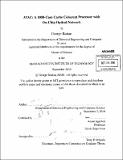| dc.contributor.advisor | Anant Agarwal. | en_US |
| dc.contributor.author | Kurian, George, Ph, D. Massachusetts Institute of Technology | en_US |
| dc.contributor.other | Massachusetts Institute of Technology. Dept. of Electrical Engineering and Computer Science. | en_US |
| dc.date.accessioned | 2011-04-25T16:00:10Z | |
| dc.date.available | 2011-04-25T16:00:10Z | |
| dc.date.copyright | 2010 | en_US |
| dc.date.issued | 2010 | en_US |
| dc.identifier.uri | http://hdl.handle.net/1721.1/62447 | |
| dc.description | Thesis (S.M.)--Massachusetts Institute of Technology, Dept. of Electrical Engineering and Computer Science, 2010. | en_US |
| dc.description | Cataloged from PDF version of thesis. | en_US |
| dc.description | Includes bibliographical references (p. 69-71). | en_US |
| dc.description.abstract | Based on current trends, multicore processors will have 1000 cores or more within the next decade. However, their promise of increased performance will only be realized if their inherent scaling and programming challenges are overcome. Fortunately, recent advances in nanophotonic device manufacturing are making CMOS-integrated optics a reality-interconnect technology which can provide significantly more bandwidth at lower power than conventional electrical signaling. Optical interconnect has the potential to enable massive scaling and preserve familiar programming models in future multicore chips. This thesis presents ATAC [13], a new multicore architecture with integrated optics, and ACKwise, a novel cache coherence protocol designed to leverage ATAC's strengths. ATAC uses nanophotonic technology to implement a fast, efficient global broadcast network which helps address a number of the challenges that future multicores will face. ACKwise is a new directory-based cache coherence protocol that uses this broadcast mechanism to provide high performance and scalability. Based on 64-core and 1024-core simulations with Graphite [20] using Splash2, Parsec, and synthetic benchmarks, we show that ATAC with ACKwise out-performs a chip with conventional interconnect and cache coherence protocols. On 1024-core evaluations, ACKwise protocol on ATAC outperforms the best conventional cache coherence protocol on an electrical mesh network by 78% with Splash2 benchmarks and by 61% with synthetic benchmarks. Energy simulations show that the energy consumption of the ATAC network that assumes aggressive optical technology predictions is 2.24x lower than that of an electrical mesh network. However, with conservative optical technology predictions, the energy consumption of the ATAC network is 1.5 1x higher than that of an electrical mesh network. | en_US |
| dc.description.statementofresponsibility | by George Kurian. | en_US |
| dc.format.extent | 71 p. | en_US |
| dc.language.iso | eng | en_US |
| dc.publisher | Massachusetts Institute of Technology | en_US |
| dc.rights | M.I.T. theses are protected by
copyright. They may be viewed from this source for any purpose, but
reproduction or distribution in any format is prohibited without written
permission. See provided URL for inquiries about permission. | en_US |
| dc.rights.uri | http://dspace.mit.edu/handle/1721.1/7582 | en_US |
| dc.subject | Electrical Engineering and Computer Science. | en_US |
| dc.title | ATAC : A 1000-core cache coherent processor with on-chip optical network | en_US |
| dc.title.alternative | 1000-core cache coherent processor with on-chip optical network | en_US |
| dc.type | Thesis | en_US |
| dc.description.degree | S.M. | en_US |
| dc.contributor.department | Massachusetts Institute of Technology. Department of Electrical Engineering and Computer Science | |
| dc.identifier.oclc | 711092531 | en_US |
